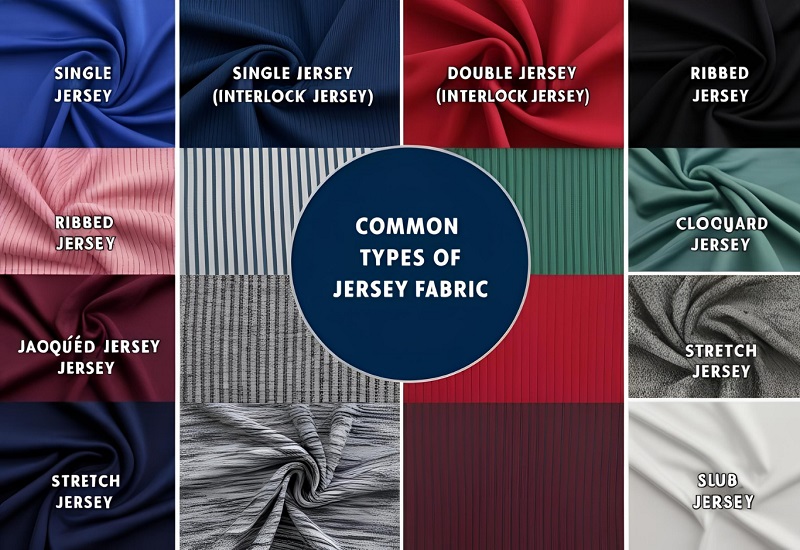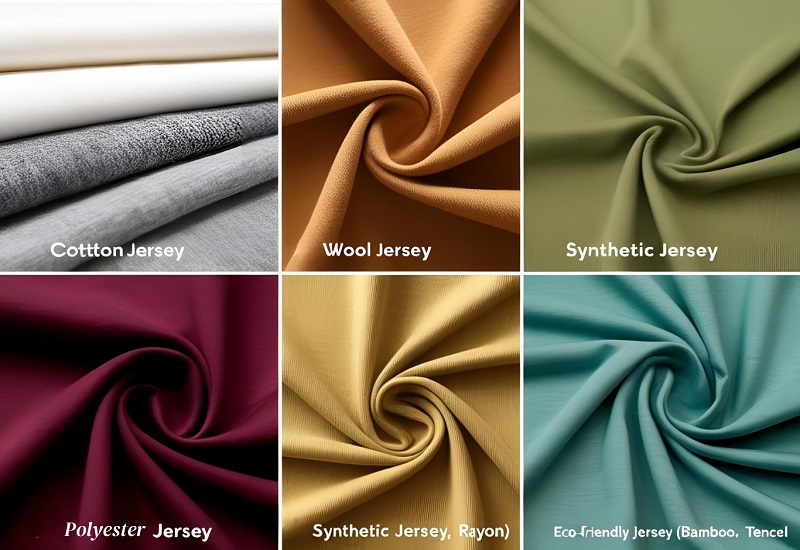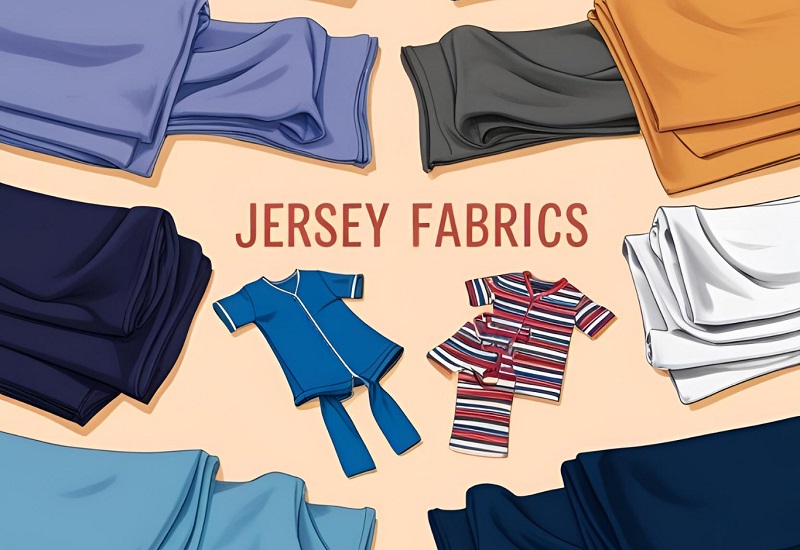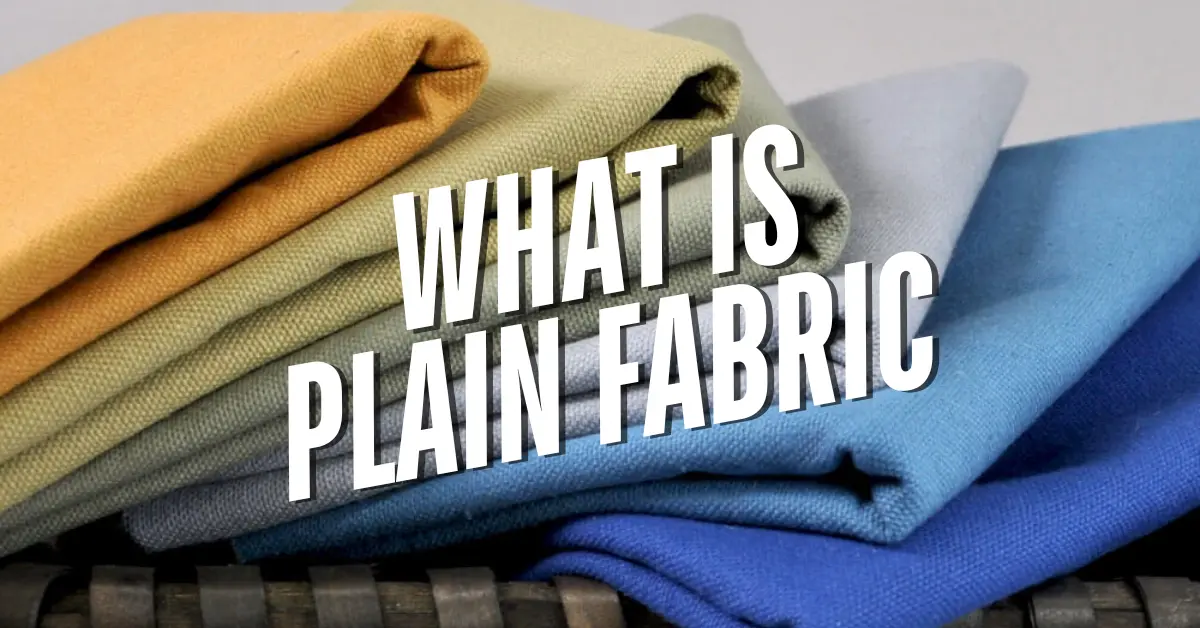Jersey fabric is a popular knitted textile used across various industries, from casual clothing to activewear. Its stretch, comfort, and softness make it ideal for daily use. As a textile engineer with hands-on experience in fabric production, I’ll explain the types of jersey fabric, their fiber bases, and where they’re best used.
What Is Jersey Fabric?
Jersey is a knitted fabric known for its flexibility, smooth surface, and natural elasticity. It is produced using a single or double-knit process, which affects the fabric’s weight, stretch, and durability. Originally made with wool, jersey fabric now comes in a wide range of fibers like cotton, polyester, and blends.
Common Types of Jersey Fabric

Each type of jersey fabric is designed with a specific knit and end-use in mind. Here are the key types used in textile manufacturing:
Single Jersey
Single jersey is a lightweight knit made using one set of needles. It has a smooth front and a textured back. This type is breathable and soft, often used for t-shirts, dresses, and sleepwear.
Double Jersey (Interlock Jersey)
Double jersey, also called interlock jersey, is made with two layers of knit. It’s thicker, more stable, and less likely to curl at the edges. This fabric works well for structured garments like skirts, leggings, and uniforms.
Ribbed Jersey
Ribbed jersey features vertical ridges created by alternating knit and purl stitches. This structure gives it excellent stretch recovery. Ribbed jersey is ideal for collars, cuffs, and body-hugging garments.
Jacquard Jersey
Jacquard jersey includes patterns woven directly into the knit using complex machinery. It offers both design and function, commonly found in sweaters and fashion tops.
Clocqué Jersey
Clocqué jersey is a textured knit with a raised surface. The puffed texture is made by combining different tension yarns. This fabric is used for upscale blouses and dresses.
Stretch Jersey
Stretch jersey includes elastane or spandex fibers. It is soft, highly elastic, and perfect for bodycon dresses, leggings, and athletic gear.
Slub Jersey
Slub jersey features uneven yarns that give a subtle texture to the surface. It’s lightweight and breathable, used in relaxed clothing like casual tees and tops.
Material-Based Variations of Jersey Fabric

Jersey fabric can also be classified based on the type of fiber used. Fiber choice affects the feel, durability, and performance.
Cotton Jersey
Cotton jersey is soft, breathable, and absorbent. It’s the most common type of jersey used for casual wear. Its comfort and ease of dyeing make it a top pick for daily garments.
Wool Jersey
Wool jersey is warm, stretchy, and insulating. It retains shape well and is often used for winter clothing like sweaters and scarves.
Synthetic Jersey (Polyester, Rayon)
Polyester and rayon jersey fabrics are smooth, strong, and wrinkle-resistant. They have excellent color retention and are used in sportswear and dresses.
Eco-Friendly Jersey (Bamboo, Tencel)
Bamboo and Tencel jerseys are biodegradable, soft, and moisture-wicking. These fabrics support sustainable production and are gaining popularity in eco-conscious clothing lines.
Choosing the Right Type of Jersey Fabric

When selecting a jersey fabric, consider the garment type and functional needs:
- Use single jersey for lightweight shirts and tops.
- Choose interlock or ribbed jersey for structure and stretch.
- Go for stretch jersey in leggings and sportswear.
- Pick wool or bamboo jersey based on climate and sustainability needs.
Care Tips for Jersey Fabrics
Proper care extends the life of any type of jersey fabric. Follow these simple steps:
- Wash in cold or lukewarm water to avoid shrinkage.
- Use mild detergent to protect fibers.
- Dry flat or tumble dry on low to maintain elasticity.
- Iron on low heat if needed, especially for cotton or wool blends.
Conclusion
There are several types of jersey fabric, each with its unique structure, fiber content, and usage. Whether you’re producing sportswear, casualwear, or high-end fashion, choosing the right type of jersey fabric ensures comfort, performance, and durability. Use this guide as a reference in textile selection and fabric sourcing to match each jersey fabric with the correct application.

Manager – Fabric Technical and Sourcing/Product Development/ Sustainable Material Management.
I am a B.Sc .-educated Manager of Fabric Sourcing and Technology with extensive experience in the apparel and fashion industry. Passionate about trend analysis, fabric sourcing, and sustainable textile solutions, I thrive in fast-paced environments that demand innovation, adaptability, and leadership.
As a servant leader, I am committed to honesty, transparency, and continuous process improvement. My expertise spans fabric development, product quality management, and supply chain optimization, ensuring exceptional performance across all facets of sourcing and production.
Core Skills & Expertise
✔ Fabric Sourcing & Development – Specialized in regular and sustainable textiles (BCI, Organic, Recycled).✔ Trend Analysis – In-depth understanding of global fashion and fabric trends.✔ Product Development – Expertise in material innovation and process optimization.✔ Quality Management – Strong focus on process control, ensuring high-quality production.✔ Leadership & Problem-Solving – Solution-oriented approach to team management and decision-making.
Technical Proficiency
🖥 Software & Tools:▪ Microsoft Outlook, Excel, Word▪ PLM (Product Lifecycle Management)
🌱 Sustainable & Ethical Practices:▪ Better Cotton Initiative (BCI)▪ Organic & Recycled Fabric Management
Key Strengths
✅ Solution-Focused Leadership – Driving innovation and efficiency in fabric sourcing.✅ Quick Decision-Maker – Adapting to market shifts and production challenges.✅ Team Player with a Positive Attitude – Ensuring collaboration and productivity.✅ Strong Time Management – Meeting deadlines while maintaining quality.
Professional Achievements
🏆 Li & Fung GEM Award – Recognized for fabric sourcing and supply chain management excellence.🏆 Group CEO GEM Award – Honored for outstanding leadership and process innovation.

